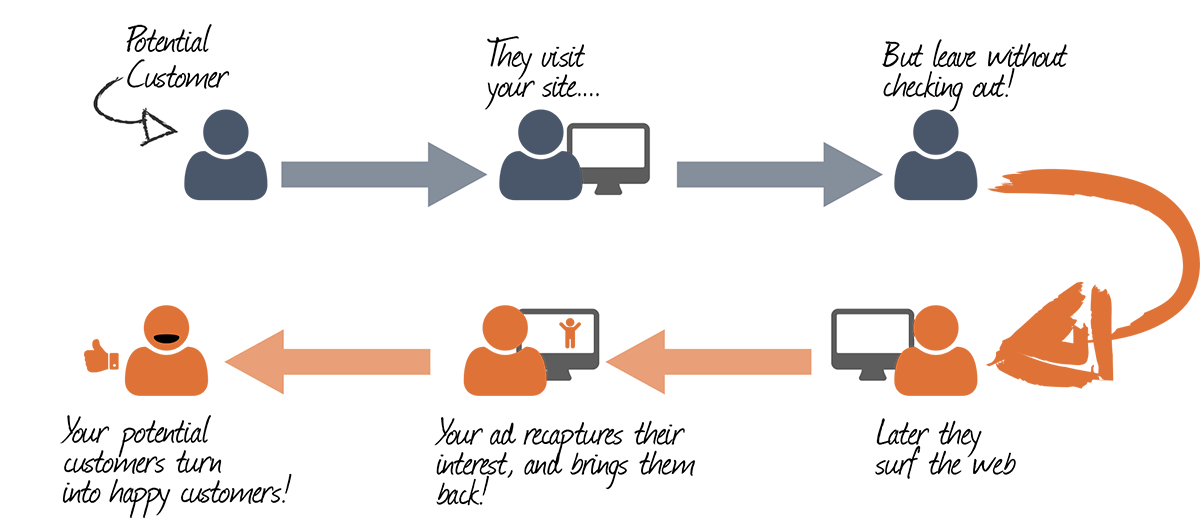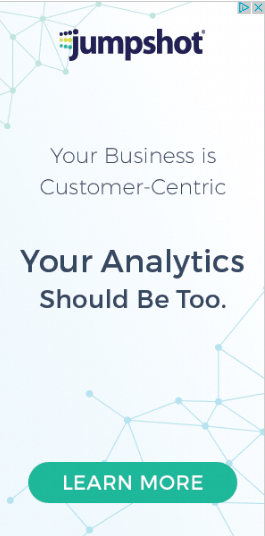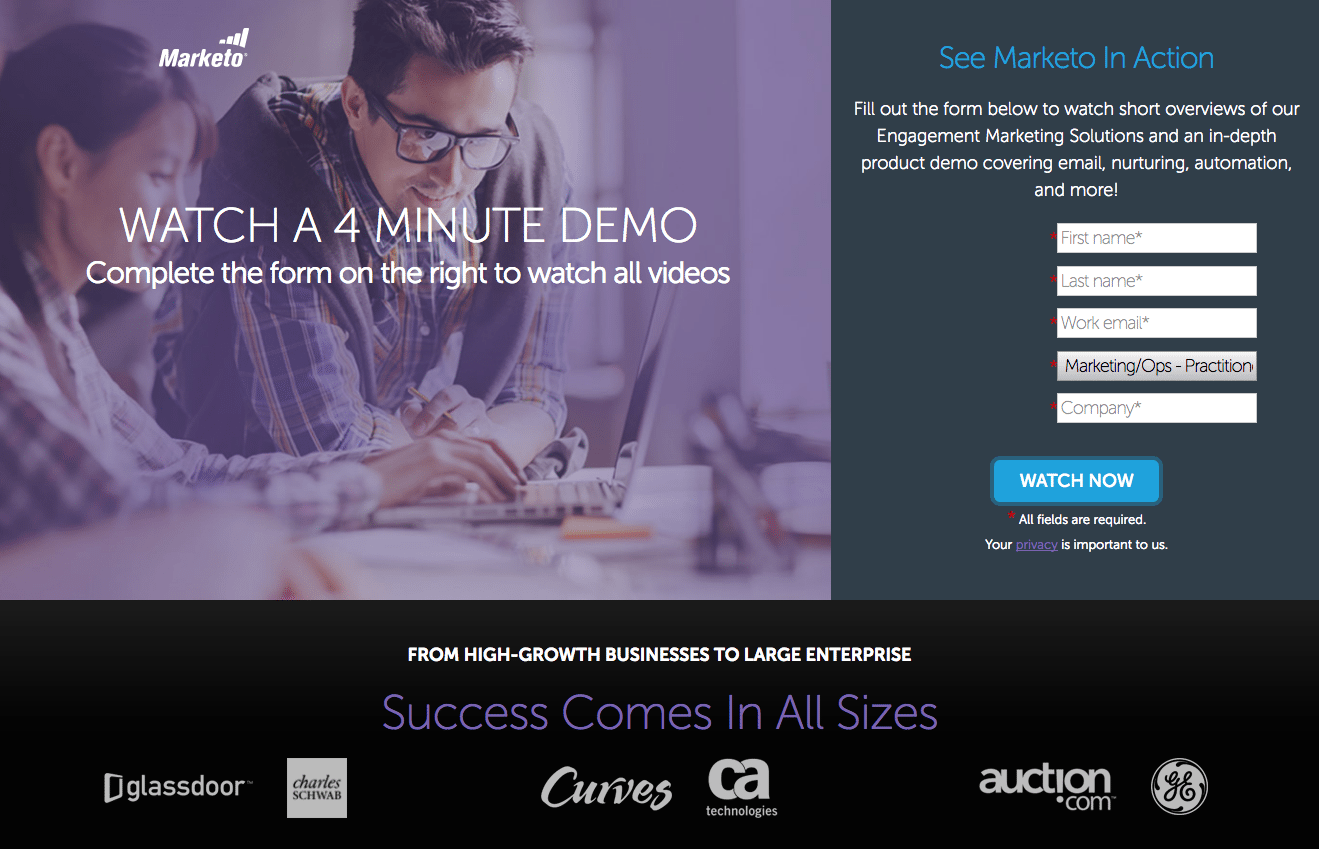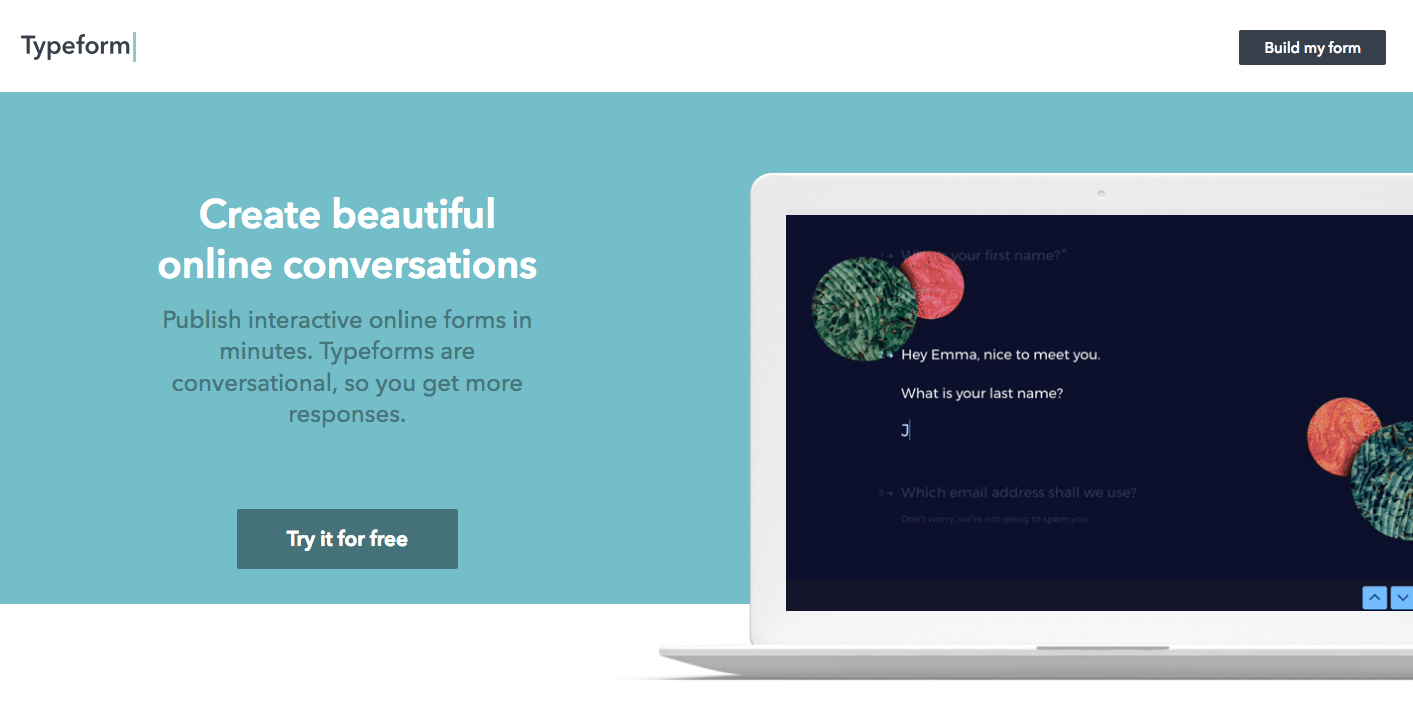‘Retargeting’ may sound like a step-too-far for those unfamiliar with online marketing, but it is in fact a simple – and very powerful – tool in the law marketer’s armoury that can help law firm marketing online deliver the results you seek.
In today’s legal landscape, becoming best known is key for dominating your market (or even just staying relevant). This is equivalent to brand awareness — and a central component of a truly effective brand awareness campaign is retargeting.
What is retargeting, Anyway?
Essentially it is a way to keep your brand and your law firm top-of-mind for your audience after they leave your website.
It is, in many ways, law firm online marketing at its very best. And most powerful.
The following visual developed by Retargeter explains how retargeting campaigns work:

The key to a retargeting campaign is that it lets you get visitors to your site with ads that they have expressed interested in already.
This retargeting is done with the help of tracking pixels or cookies that follow the user around after they leave your website.
These retargeting ads are served through third-party networks such as the Google Display Network and Facebook, thus spreading your online law marketing net as wide as possible through a multitude of different websites.
That is the key to retargeting. Search engines and social media channels let you prompt or remind potential clients of what your law firm can do for them to solve an issue or help with some legal query or problem.
It can hugely increased targeted traffic to your site.
To achieve the best results it is best to use segments of your potential audence and provide information based on those areas of interest. That is targeting.
When optimized the right way retargeting campaigns have the power to convince visitors who might otherwise be hesitant or uncertain to go back to your site. It also lets existing clients know what you’re doing as well.
Google’s ‘Remarketing’ Terminology
Google will often refer to retargeting ads and emails under the terminology of ‘remarketing’, which is picked up by many marketers.
Google essentially groups retargeting display ads and remarketing emails under the single terminology of “remarketing” and most marketers follow the same definition.
How to gather data for retargeting campaigns
Unlike search ads, retargeting ads aren’t initiated by user queries, to ensure that the right audience sees your ads.
How do you go about getting that data? Here are two key ways to use for your online law firm marketing that can generate your major online traffic boost.
1. Use a retargeting pixel
Pixel-based retargeting is the most common form of audience collection. It works with the help of a JavaScript code (a pixel) that you place on your website or post-click landing page.
That may all sound complicated, but it’s simple to put into effect. YOu simply attach a pixel when any visitor arrives at your website and it drops an anonymous browser cookie in the browser of your visitor.
This is the pixel that ‘follows’ your visitors when they continue to browse, working via Facebook and Google Adwords.
It also starts instantly as soon as the pixel is activated.
2. Use a retargeting list
With list-based retargeting, you use lists of your existing customers or visitors who have provided you with their email address and show specific ads to them. Maybe you want your blog subscribers to download a whitepaper whose pop-up ad they have been ignoring on your homepage, or you want your free trial users to upgrade to a paid plan. Both situations would be appropriate for retargeting campaigns.
To start with list-based retargeting, simply upload the list of email contacts you have to the retargeting platform of your choice, and your audience should start seeing your ads as they browse through the web. You can also send your audience personalized emails to convince them to revisit the offer they showed interest in.
Retargeting campaign goals
There are two basic goals you can set for your remarketing campaigns:
- Awareness: Awareness campaigns are used to inform visitors about your product features and other announcements. This is a less targeted goal because it’s directed at visitors who haven’t interacted a lot with your business. You can run awareness campaigns as a precursor for your conversion campaigns.
- Conversion: Conversion campaigns are used for visitors who are more familiar with your brand and its products or services. But, they still haven’t committed to an offer, so you want them to click on the ad, direct them to a post-click landing page, and convince them to convert.
Regardless of the campaign goal, the key in creating successful retargeting campaigns lies with audience segmentation. For retargeting campaigns, you can create the following audience segments:
- By behavior.
- With time.
- Existing customers.
Retarget by behavior
There are two types of behaviors a visitor can showcase when they’re on your website:
- Not Interested (the visitors spend less than a few seconds on your website, don’t go to any other page on your site and immediately exit)
- Interested (the visitors browse through the website content, maybe even click through to other pages like the resources page, pricing page, or the about us section).
The “Not Interested” segment of visitors have very low intent, so serving them retargeting ads will only add to your cost and will not favor your ROI. Meanwhile, the “Interested” visitors show high intent and a much higher probability of returning to your brand and buying something if they are served with the right ad messaging.
You can create further segments in the “Interested” audience segment and customize retargeting ads for people based on the exact behavior they demonstrated on your website.
There is also the option of using soft-sell retargeting ads (ads that ask visitors to opt-in to an email list in exchange for a free ebook or newsletter etc.) for visitors who have gone through the resources section or blog. You can move in for the hard sell for visitors who have visited your product page and spent time looking at your pricing plan, as their intent of buying was high.
Retarget by time
This strategy encompasses three things:
- Time duration between the visitor’s website visit and when they get to see the first ad.
- The frequency with which visitors see particular ads.
- Time duration between the visitor’s first visit to the website and the time when they stop seeing retargeting ads.
In both Google AdWords and Facebook, the default time duration for when a visitor gets added to your retargeting list is set to 30 days by default. It’s important to remember that when a visitor resets the 30-day cycle if they revisit the website within the first 30 days.
Both advertising platforms give you the option to increase this limit depending on your campaign. However, be careful not to show your ads too soon as this can irritate online users and create a negative perception about your brand. This is particularly the case in the case of a visitor who only spent a few seconds on the website.
Another thing to take care of is the frequency with which visitors see your ads. Showing the same ad more than once on a single website is not a good idea.
Retarget by existing customers
One great time to target existing customers with retargeting campaigns is after releasing a new feature or a pricing plan update. These types of campaigns can yield great results especially for customers who aren’t that active on your platform; maybe the new feature update can convince them to become more active?
Now that you know what goals to set for your retargeting campaigns and how to segment your audience.
How to set up retargeting campaigns in Google AdWords
The Google Display Network Reach in the US is considerably high, reaching over 92% of visitors across millions of websites, videos, and devices.
Follow these steps to successfully set up a retargeting campaign in Google AdWords:
- Sign-in to your AdWords account.
- Open the ‘Shared Library’ option.
- Click ‘Audiences’.
- Do ‘Set-up Remarketing’.
- Click ‘View AdWords Tag for websites’.
- Select and copy the provided remarketing tag code. The tag will work for both mobile and desktop websites.
- Place the tag code at the bottom of the website pages you want to use for your campaign.
- Save and publish your page.
- Use ‘Google Tag Assist’ to check if your tag is working properly
- Click ‘Continue’
- Click ‘Return to Audiences’
In a few days, the tag will start collecting the cookies of website visitors, and the ‘All Visitors’ list in your account will begin to fill up.
This is what a typical Google AdWords retargeting ad looks like:

With Google AdWords retargeting you can create customized lists, run tests such as frequency cap testing, ad testing, custom combination testing, and bid tests. The search engine advertising network also offers the following types of retargeting campaigns:
- Standard Remarketing: showing ads to past visitors as they visit Display Network websites and use Display Network applications.
- Dynamic Remarketing: The ads shown to visitors include specific products or services that they browsed through on your website.
- Remarketing for Mobile Apps: Show ads to visitors who have either used your mobile app or mobile website.
- Remarketing Lists for ads: Show ads to visitors as they do follow-up searches for what they need on Google.
- Video Remarketing: Show ads to visitors who have opened your YouTube videos.
- Email List Remarketing: Upload a list of your customers’ email addresses. And when these visitors browse through different websites, they can see your display ads.
When you choose to run your retargeting campaigns through Google your ads get the most exposure across the internet.
How to set up retargeting campaigns in Facebook
To start with a Facebook retargeting campaign you need to have a Facebook account for Business ads. When you’re all done with the account setup, go to the Audiences section in the Facebook Ads Manager.
Then select the “Custom Audiences” option for retargeting. This allows you to reach out to visitors with relevant ads who have already been on your website.
From the list of “Custom Audiences” select the “Website Traffic” option. It lets you create a list of people who have visited your website or viewed specific web pages.
Now select the audience you want to target your retargeting ads to from the drop-down menu in the “Website Traffic” tab.
These are the given audience options:
- Anyone who visits your website
- Users who visit specific pages
- Prospects visiting specific pages but not others
- Visitors who haven’t visited in a certain amount of time
- Custom combination
After selecting the audience options, Facebook provides you their pixel tracking code (aka the Facebook Pixel). Place this tracking code on the website to track visitors.
Facebook retargeting allows you to track conversions on your Facebook ads, optimize ads based on the data that you gather from your campaigns, and then create better ads in the future.
This is what a typical Facebook retargeting ad looks like:

The added advantage of using the Facebook Pixel for retargeting campaigns is that it can also be used to serve retargeting ads to your visitors on Instagram.
With the campaigns all set up and audience segments selected, all that’s needed now is to create the retargeting ad. However, simply creating a retargeting ad won’t bring back visitors. You must optimize the ads to convince online users to click and return to your page.
Optimizing retargeting ads
Retargeting campaigns essentially consist of display ads that use images, video, and rich media types to engage audiences.
To create effective display ads, ensure the image and copy are relevant to the product feature or offer you’re trying to grab the visitor’s attention with.
Creating different display ads for each retargeting audience segment helps you create ads that appeal to the visitor you’re trying to get back.
An optimized retargeting ad has the following elements:
- An engaging headline: This should be relevant to the visitors’ experience on your website. And it should be written in a way that piques their attention.
- Relevant, visually appealing media: You can include an animation or a static image on your display ad. However the chosen media should be relevant to the offer showcased in the ad copy.
- A click-worthy CTA button: This should be designed in a contrasting color and have actionable, personalized copy on it. (e.g. “Show Me the Ebook”)
- Actionable copy: Display ads are not meant for lots of copy and you have limited characters to explain the offer. Ad copy that gets to the point quickly and offers visitors an incentive to click will likely produce more clicks.
Marketo’s retargeting ad fills all the right optimization boxes:

- The headline explains to the visitor what they’ll get when they click the ad.
- The CTA button is contrasting with the rest of the ad.
- The image is relevant to the offer.
Once online users click Marketo’s ad, this dedicated post-click landing page continues the conversion sequence:

All retargeting ads should be connected to post-click landing pages instead of the homepage, because post-click landing pages can provide better message match and the optimal 1:1 conversion ratio that convinces them to convert.
Dedicated post-click landing pages give you the unique opportunity to attract audiences with the same message that convinced them to click the ad. This helps them see what they wanted without any distractions and increases the possibility of them clicking the CTA button.
Typeform’s retargeting ad and post-click landing page are also optimized for conversions:


Optimized post-click landing pages help you transform warm leads into red-hot conversions with the help of relevancy and conversion-centric elements. To ensure that you’ve created a perfectly optimized post-click landing page, review our comprehensive post-click landing page guide here.
Leverage retargeting campaigns more effectively
Retargeting provides you incredible opportunities to target exactly the customer you want by giving you another chance to display your brand and message to users who have already shown interest. Don’t waste it by directing visitors to a page that won’t get you immediate conversions for a specific offer — like a cluttered homepage.
Create optimized retargeting ads and connect them to dedicated post-click landing pages to get the most out of your campaigns. The best solution for that is Instapage because you’ll enjoy 100% customization and the most designer-friendly platform to turn clicks into conversions.